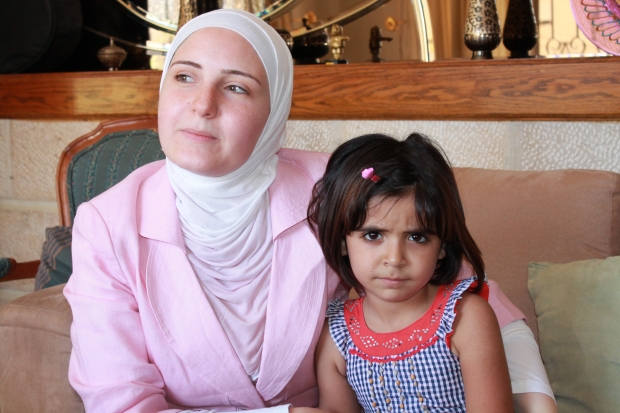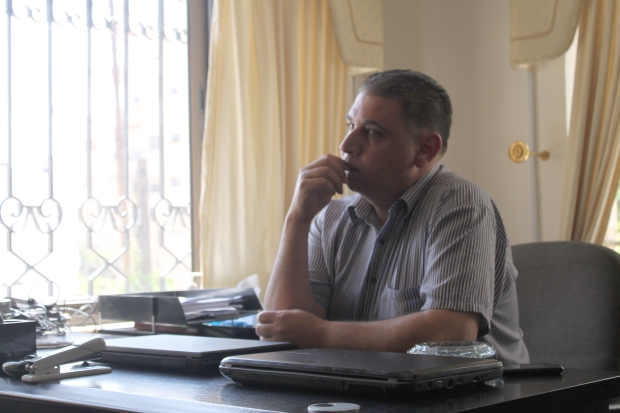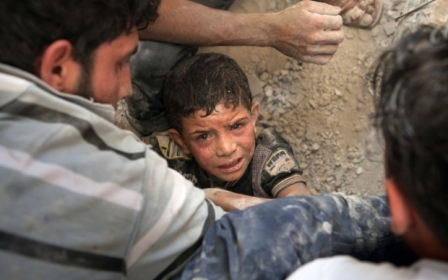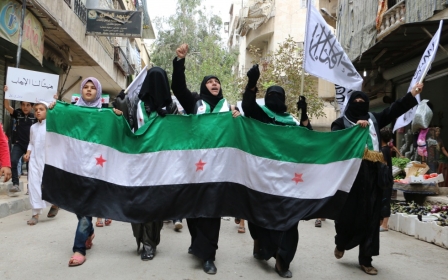Syria’s luckiest amputees

AMMAN - Motherless, brotherless and with two broken legs, 12-year-old Brahim doesn’t yet know how lucky he is.
When a bomb landed on Brahim’s home in Ghouta, near Damascus, his mother and three brothers were killed instantly. Brahim’s father scooped up his broken, bleeding son, leapt into the car and bolted for the Jordanian border where the unconscious boy was transferred to ambulance and despatched to a nearby hospital.
Multiple operations later, Brahim’s shattered legs are healing at a donation-funded Amman recovery centre for war-wounded Syrians. He requires additional surgeries but his prognosis, says a doctor, is good. He was lucky.
And he was - three times over - lucky to make it to Jordan, lucky to be admitted to hospital, luckier still to have somewhere safe to heal. Increasingly, others are not so fortunate.
Since the start of the Syrian war, casualties chewed up by blasts and battle have been rushed to the Jordanian border for urgent medical help. Families of the injured and the patients themselves say it typically takes around 20 minutes for security checks and transfer into ambulances. More urgent cases tend to move faster.
From the border, patients typically go to one of six hospitals that offer care to Syrian refugees: two in the city of Ramtha, just a few kilometres from the border, and four in Amman, an hour or so away.
The crippling cost of care
According to Jordan’s Ministry of Health, 264,891 wounded Syrians were treated in the kingdom from the beginning of 2012 to mid-2014. More arrive every day – the guaranteed by-product of a war like this is a constant stream of damaged men, women and children.
Heavily indebted and reliant on aid to keep itself afloat, the kingdom has struggled to pay for the care of wounded Syrians. Although most hospitals that accept war-wounded patients rely on donations rather than government money to fund that care, there are knock-on costs that get passed to the ministry.
“It frequently happens that Jordanian patients come here and there’s no bed for them because the beds are full of Syrians. In that case the Jordanian patient is transferred to private hospital or King Abdullah [a university hospital also in Ramtha] but still, the Ministry of Health pays,” said Dr Yousef Tahat, the director of Ramtha Hospital, where the NGO Medecins Sans Frontieres runs and funds a surgical programme for war-wounded Syrians.
In late November, after months of warnings that it could not cope with the costs, the government revoked free medical treatment for Syrian refugees, citing a $30 million bill. Syrians must now pay for their own healthcare, even if just a nominal fee. But with refugees prohibited from working, it’s not yet clear how they will cope.
Caught on the wrong side of the border
There’s another cost that is harder to measure: security risks. Since late September, Jordanian authorities have slashed the number of refugees allowed into the kingdom. According to an internal humanitarian email, between 31 October and 10 November, not a single refugee was admitted.
Registrations of new refugees, carried out by UNHCR, have dropped to their lowest levels since the conflict began. Jordanian authorities insist they maintain an open border policy, but the numbers suggest that in practice the border is closed.
Urgent war-wounded cases are not technically refugees - only when they are discharged from hospital are their asylum claims heard. But in October, internal documents from humanitarian groups accused Jordanian authorities of slowing the admission of war-wounded people along the western stretch of the border, where Brahim crossed, and refusing to grant entry to anyone without ID.
In mid-November, two boys died because of these delays. An insider said the critically injured brothers were held at the border for so long that one bled to death on the Syrian side. Officials then admitted his brother, but it was too late, as the child bled out before he could reach a hospital.
Both aid workers and officials say Jordan is still accepting war-wounded Syrians, and the hospital programmes serving these people are still running, but the incident clearly rattled some members of the humanitarian community.
Injured Syrians ‘being deported’
Compounding the border issues, in late October, word began to circulate among refugees and aid workers that deportations were on the rise. An internal humanitarian document dated 10 November revealed concerns that more and more Syrians, including the wounded and people registered with UNHCR, were being returned from Jordan to Syria. Cases include children, the elderly and a woman in labour.
On 24 November, Human Rights Watch issued a statement calling on the Jordanian government to stop forcibly deporting Syrian refugees. It raised the case of a group of 12 refugees - including six paralysed men and two wounded children - who had been receiving treatment at the Dar al-Karama rehabilitation centre in Ramtha. The centre was raided and closed by Jordanian police and the group sent back to Dera’a, Syria, where the care they need is not available. The centre itself has not yet been re-opened.
“War-wounded Syrians suffer the types of injuries that require months and even years of physiotherapy and rehabilitation,” said Adam Coogle, a Middle East researcher with Human Rights Watch. “Jordan’s closure of informal rehabilitation centres for Syrians removes the opportunity for this essential care and makes it more difficult for Syrians to recover from their injuries.”
The Dar al-Karama statement includes the government’s reason for closing it down - they say neither the centre nor its staff were properly licensed.
Coogle, on the receiving end of too many cries for help from wounded refugees about to be deported, thinks this is no excuse. “Jordan should work with Syrian medical personnel to register these informal centres rather than shut them down.”
Welcome to Souriat Without Borders
But not all of these informal centres have been shut down. On a quiet side street near Amman’s university district, Souriat Without Borders - a squat, four-storey villa repurposed as a rehabilitation centre for war-wounded Syrians - is running at full capacity.
Brahim is here, sitting up in his metal gurney and playing a video game, as are another 30 inpatients. Keeping it going is Samara Atassi, a 31-year-old British-educated pharmacist from Homs, together with Dr Amer, a Russian-trained maxillofacial surgeon, three nurses, three physiotherapists, one psychologist and seven cooks and cleaners. Bar one Jordanian physiotherapist, everyone is Syrian.
“Welcome to Souriat Without Borders,” says Atassi with a broad smile.
“Souriat” means “Syrian women” in Arabic, and Atassi is one of five Syrian expats - living in Canada, Saudi Arabia, Jordan and UAE - who founded and fund this centre.
“We met on Facebook,” says Atassi. “A woman posted a note saying ‘I want to go to Jordan to help Syrian refugees, so anyone who wants to come with me, write your name.’” Atassi was already in Jordan at the time. The women pooled their means and leveraged their contacts, and on 1 March 2013, Souriat Without Borders opened its doors.
Atassi found the first patients through the doctors who operated on them. She offered after-care, rehabilitation, prosthetics and psychological support - the things war-wounded patients need when they are discharged from hospital but can ill afford.
Close contact with doctors and an unending stream of Syrians with devastating injuries means Souriat Without Borders is full most of the time. “If they are stable but need care or prosthetics or physiotherapy, they come to us,” Atassi says proudly.
The centre costs around 20,000 Jordanian dinars (US$28,414) per month to run. Rent is paid up front, a calendar year at a time. Running costs are raised month to month. The NGO Handicap International provides prosthetics – most patients require prosthetic limbs, usually one or both legs – and other non-profits provide funding or support in kind. In its first year and a half, the centre was home for more than 150 patients, most for several months at a time.
We are their last chance
Souriat Without Borders is registered with the Jordanian authorities and every month government officials come to check on care and take the names of patients. Atassi cooperates and gives them whatever they need. “It’s better for us and for them,” she says. While she believes her cooperation with authorities will keep the centre safe, her colleague Dr Amer fears darker days are to come.
“We don’t know the real reasons behind the closures of the other centres, and this worries us. What would happen to the wounded if we had to close? Most of them don’t have relatives in Jordan to take care of them,” he said.
Like Coogle and many others in the humanitarian community, Dr Amer appreciates that the decision to scrap free healthcare for Syrian refugees reflects shortage of money as opposed to a shortage of empathy. But its effect galls him.
“The vast majority of Syrians have been adversely affected by this decision. I know someone who has a child with kidney failure requiring dialysis three times per week. In this case the cost is $1,000 per month and that means, what, the death of this child?”
Although the centre runs a waiting list, Dr Amer and Atassi move mountains, schedules and furniture to accommodate the need. As they talk about patients past and present, it becomes clear they see their centre as a last chance, a way back from the brink of depression and misery for those who no longer recognise themselves in their broken bodies.
One particularly challenging patient, Atassi recounts, arrived in Jordan unconscious and without ID. He came out of surgery unresponsive, mute and anonymous. The hospital wasn’t optimistic but she brought him to Souriat Without Borders and he slowly came back to life. The man remained mute but learned sign language from his therapists. A photo posted to Facebook reunited him with his family, and he now lives an independent life in Jordan.
‘Every patient here thinks he will die next’
More patients are found than lost, but those who don’t make it cast a shadow that is felt by patients and staff long after their deaths.
On the first of Middle East Eye’s visits to the centre, a 26-year-old patient named Rabia was talking to Brahim, gently teasing him. Their beds were next to each other, and their rapport was like brothers. Even sitting up on his bed, Rabia was hunched over, his mid-section scooped out. Paralysed from the waist down after he was hit by a sniper’s bullet in the pelvis, Rabia had no kidneys and suffered regular convulsions. He had, he said wryly, no hope.
“Rabia came to us for the psychology. When we first saw Rabia he was in a small room with his brother and there was no one opening up to him. When he came to us he changed a lot, speaking with others,” says Atassi.
The day after MEE’s first visit, Rabia died. Twice-weekly dialysis had raised the potassium levels in his body and his heart stopped beating.
Dr Amer, stoic as they come, had difficulty breaking the news of Rabia’s death to patients. Only when he was alone did he break down.
Weeks later, talking about Rabia’s death made him visibly emotional. “He had been with us a year. My wife knew his name, my children knew about him,” he said, voice faltering before he paused and cleared his throat.
For Atassi, there is comfort in that she and her colleagues genuinely did all they could. “Every time I went to speak with him, to tell him he had to move on so someone else could take the bed, something in my heart stopped me. I postponed every time. When he died I was happy, because I never had to tell him,” she said.
Rabia’s death shook the group of men on the ward. One patient asked for his jacket, Dr Amer said, so he could feel close to Rabia, or perhaps so he was more prepared to die.
“Every patient here thinks he will die next,” said Dr Amer, sighing and shaking his head.
A source of hope
Most of the patients at Souriat Beyond Borders don’t die - they stabilise, heal, get fit for prosthetics and learn to walk, eat and manage their lives with their new bodies.
For young patients like Brahim, seeing men with injuries like his leaving the centre and restarting their lives is a source of hope. For some of the female patients on the floor above, many with two prosthetic legs, seven-year-old Safar, scampering around the ward with a prosthetic right leg and an impish grin, is a flicker of hope – if she can do it, I can too.
The unflagging commitment of the team underscores the message: we get up and we keep moving forward. Dima, one of the physiotherapists, accepts no excuses from her patients: “Outside, I’m your friend. But when I enter the room I become firm.”
Down in the men’s ward, Brahim is being roused for a meal. Afterwards there will be physical therapy. He grumbles, but he gets moving. He’s lucky to be here.
New MEE newsletter: Jerusalem Dispatch
Sign up to get the latest insights and analysis on Israel-Palestine, alongside Turkey Unpacked and other MEE newsletters
Middle East Eye delivers independent and unrivalled coverage and analysis of the Middle East, North Africa and beyond. To learn more about republishing this content and the associated fees, please fill out this form. More about MEE can be found here.







